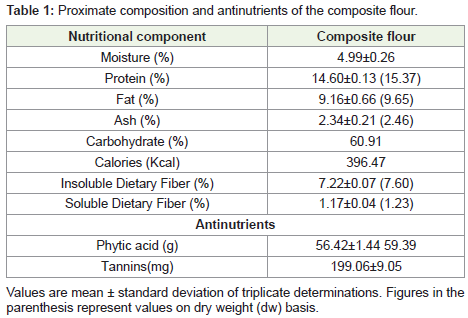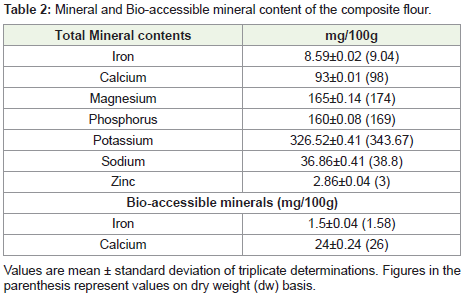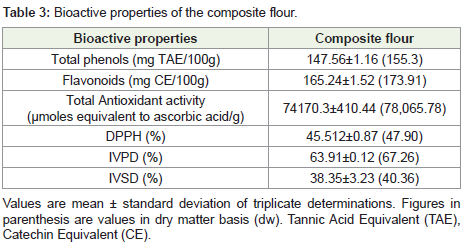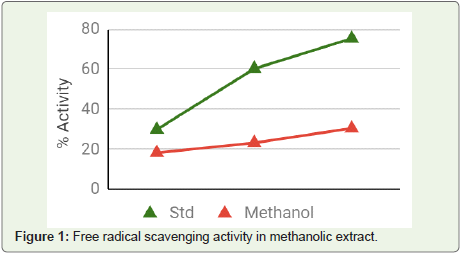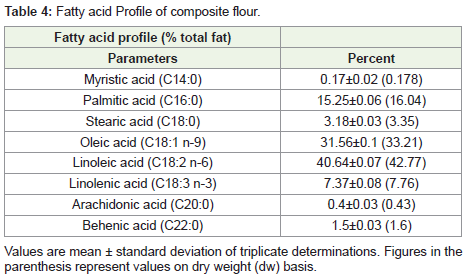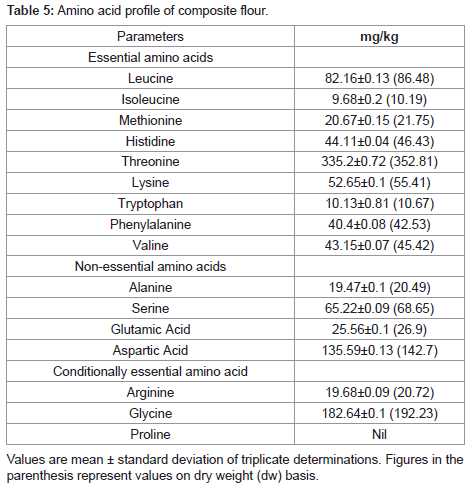Research Article
Nutritional and Bioactive Properties of Foxtail Millet Based Composite Flour
Sindhu A Divakar* and Jamuna Prakash
Department of Food Science and Nutrition, University of Mysore, India
*Corresponding author: Divakar SA, Department of Food Science and Nutrition, University of Mysore, Mysuru, India Email: sindhudivakar@gmail.com
Article Information: Submission: 03/01/2021; Accepted: 27/01/2021; Published: 01/02/2021
Copyright: © 2021 Divakar SA, et al. This is an open access article distributed under the Creative Commons Attribution License, which permits unrestricted use, distribution, and reproduction in any medium, provided the original work is properly cited.
Abstract
In recent times composite flour blending technology using whole grain, under-utilized crops such as millets and pseudo cereals has increased in order to evaluate the feasibility of utilizing locally available alternative grains. In light of this, the present study was designed with the objective of formulating composite flour utilizing foxtail millet, cereal, pseudo cereal, oilseeds and spice. The results revealed that the whole grain and millet based composite flour was rich source of nutrients such as protein, fat and dietary fibre. The composite flour contained bioactive components like total phenols (155.3 mg TAE/100g), flavonoids (173.91 mg CE/100 g) and also displayed a high free radical scavenging activity in methanolic extract. The flour displayed a high protein digestibility (63.91%) with good quality essential amino acids, poly unsaturated fatty acids and mono unsaturated fatty acids. The flour being an excellent source of nutrients, bioactive components and low on starch digestibility could find a potential use in development of nutritious product for all age groups.
Keywords
Composite flour; Under-utilized crops; Bioactive components; Total phenols; Flavonoids
Introduction
Millets, known as the small seeded grains are most important drought resistant crop having a shorter growing period. Better production capabilities under stressful climatic conditions and resistance to pests and diseases make them a sustainable crop [1]. Foxtail millet (Setaria italica) is one such millet known to be the oldest cultivated crops, which has been identified as the sixth highest yielding grain in terms of worldwide production, as reviewed by Saleh [1]. Due to recent interest in millets and research providing knowledge about the nutritional and medicinal properties, it is gaining popularity and finding a place all over the world [3-5]. Among
the wide range of health promoting components, they are known to be rich in antioxidants, phenolics, dietary fiber, protein, fat, starch, vitamins and minerals [6]. The phenolics present in foxtail millet act as antioxidants by reducing the amount of free radical produced in the body. They are also known for their ability as reducing agents, metal chelators and reactive oxygen quenchers [7]. It is even observed that the fiber, possesses significant free radical scavenging activities, reducing power and ferrous ion chelating capacity [8]. With such abundant nutritional and health promoting components it is suggested that foxtail millet can be potential ingredient in food production.
Many developing countries are encouraging programs to evaluate the viability of utilizing locally available alternative flours as a substitute for wheat flour [9]. For this, development and utilization of composite flours as a mixture of different flour and other ingredients to completely or partially replace wheat flour may be the way forward [10,11]. According to researchers’ composite flours can be advantageous in terms of saving money, promotion of forgotten indigenous crops, better nutritional supplementation, better agricultural production, increased usage of locally grown crops and reduced imports of wheat [12,13]. Foods developed from composite
flours may be one of the approaches to improve the nutritional quality of the foods offered to children and adults in combating issues such as malnutrition and lifestyle disease. A study done on milletbased biscuits using millet and pigeon pea flour in different blending proportions found that all biscuits had high protein, digestible
carbohydrates and sensory scores [14]. According to Vijayakumar and Mohan Kumar [15], millet flour blends incorporation improved the quality of composite flours. Similar reports were found in another study on breakfast cereals using millets, amaranth and buckwheat. It showed that the use of these flours not just improved the nutritional quality of the extruded product but also significantly reduced the readily digestible and slowly digestible carbohydrate in a predictive in vitro glycemic profiling [16].
Thus, in this study an attempt has been made to develop composite flour using millets, cereal, pulse, pseudo cereal, oilseeds and spice which was further analyzed for its nutritional and bioactive properties.
Materials and Methods
Materials:
The raw materials selected for the study were brown rice (Oryza sativa), foxtail millet (Setaria italica), soybean (Glycine max), grain amaranth (Amaranthus), flaxseed (Linum usitatissimum) and black cumin (Nigella sativa L). These ingredients were purchased from local certified organic shop in one batch, cleaned of extraneous matter,
oven dried individually at 600 C for 30 mins. The ingredients were measured in following proportions, brown rice at 50%, foxtail millet 25%, soyabean 15%, amaranth seeds 8%, flax seeds and black cumin each at 1% and milled. The flour obtained was stored and sealed in polyethylene bags until further use. All chemicals used for the study were of analytical grade and purchased from Sd Fine Chemicals, Himedia laboratories, Qualigens Chemicals Ltd., Mumbai, India. The enzymes used, namely pepsin (Batch No. 3-0060) and pancreatin (Batch No. 0-0864) were procured from Sigma Aldrich Co., USA. Glass double-distilled water was used and all experiments were carried out in triplicate.Proximate analysis:
The moisture content of the composite flour was determined by oven drying method [17]. The micro Kjeldhal method was employed to determine the total nitrogen and the protein content (Nx6.25). Fat was estimated by extraction with petroleum ether (60-80 °C), in a Soxhlet apparatus and ash content was determined as per AOAC method [18]. Carbohydrate was calculated by difference method. Dietary fibre was estimated using the rapid enzymatic assay of [19].Antinutritional content:
The phytic acid was estimated by the method of Thompson and Erdman [20]. Phosphorous was converted into phytic acid using a conversion factor of 3.55. Condensed tannins extracted from flour using methanol was analyzed calorimetrically by the vanillin-HCl method and results expressed as milligrams of catechin equivalents per 100 g [21].In vitro digestibility:
In vitro digestibility of Protein: A method by Akeson and Stahman was followed to determine in vitro digestibility of protein in composite flour [22]. Sample containing 100 mg protein was digested with enzyme pepsin and pancreatin in required pH adjustment. The insoluble protein was separated using trichloroacetic acid and the soluble protein was centrifuged and the supernatant was digested in acid to estimate the protein by Kjeldahl method. Protein digestibility results are expressed as a percent of total protein solubilized after enzyme hydrolysis.In-vitro starch digestibility: In -vitro starch digestibility of multi-whole grain mix was estimated according to the method described by [23].
Mineral content and its Bio accessibility:
The quantification of mineral elements was carried out using an Inductively Coupled Plasma-Optical Emission Spectrophotometer (ICP-OES) (Thermo Scientific, USA). Mineral content of flour samples was analyzed by rapid digestion using HNO3 followed by H2O2, in an electrical heating block. At the end of digestion, samples were diluted with triple deionized water (Milli Q grade) at 20 ml final volume, which was further diluted 5-10 times. Elemental concentrations in the digest solutions were determined by means of Inductively Coupled Plasma Spectrometry (ICPOES) [24]. The bio accessibility of mineral in these flours was also analyzed by the in vitro method of dialysis by simulating gastrointestinal digestion [25]. The dialysates were estimated for dialyzable minerals, specifically iron and calcium. The mineral concentration was measured in Inductively Coupled Plasma Optical Emission Spectrometer (ICP-OES).Amino acid profile:
The amino acid present in composite flour was determined by ion chromatography in an Amino acid analyzer released by hydrolysis with boiling semi concentrated hydrochloric acid. Biochrom 30+ series of Amino acid analyzer from Biochrom Ltd. Cambridge, UK with two channel A/D converter card on a PC using Software for peak integration was the instrument used. The aminograms were detected at 570 nm and 440 nm [26].Fatty acid profile:
The fatty acid was measured in Gas Chromatography (GC) fitted with a capillary column (30 mx0.25 mm; 0.25 μm film thickness). GC model used-Hewlett Packard 6890/5972 system, column temperature was programmed from 60-260 °C at 4 °C/min. The carrier gas was helium with flow of 0.8 ml/min and split ratio was 1:10. The fatty
acids were identified and quantified with reference to the retention time of standard fatty acid methyl esters under similar conditions and expressed as a percentage of relative area [27].Analysis of antioxidant activity and Bioactive components:
Total antioxidant activity by Phosphomolybdenum method: This assay is based on the ability of analyte to form a green complex due to the reduction of Mo (VI) to Mo (V). The results were calculated as μmoles of total antioxidant activity per g of sample [28].Analysis of bioactive components: The different extraction media selected for estimation of total phenols and flavonoids were water, and methanol. A known amount of sample was mixed with extracting media; shaken for 3 h and filtered through Whatman filter paper No.1. Total phenols were estimated by Folin–Ciocalteuo method and values expressed as mg of tannic acid equivalents/100 g of sample [29]. The flavonoid content was estimated using the Dowd
method as adapted by Arvouet-Grand and others and expressed as mg of quercetin equivalents per 100 g of sample [30].
Free radical scavenging activity: Methanolic extracts of the sample was mixed with DPPH reagent, kept in dark for 30 min at room temperature and read for OD at 517 nm. DPPH reagent was used as blank and percentage reduction was noted. The results were expressed as percent free radical scavenging activity [31].
Results and Discussions
Proximate composition and antinutrient property:
The nutritional composition and antinutrient content of the experimental flour was analyzed and presented in Table 1. The flour with a moisture content of 4.9 %, was a good source of carbohydrate and protein which was about 57.68 and 15.31 % respectively. This could be attributed to the presence of ingredients such as brown rice, millets and other grains which are good sources of macronutrients individually [32]. Insoluble and soluble dietary fiber was high, which was about 7.6 % and 1.23 % respectively making the total dietary fiber content 8.96%. Flaxseeds being one of the ingredients used is a good source of soluble and insoluble fiber due to presence of mucilage located in outer layers of the seed [33,34]. A study on different flour fractions of whole wheat, sorghum, finger millet and pearl millet revealed that coarse flours had higher content of insoluble dietary
fiber compared to fine flours [35]. The fat content was about 9.65 % and this may be due to presence of flaxseeds, black cumin and the millet which are rich sources of fat. The ash and calorie content were in the range of 2.46% and 457 Kcal respectively. The composite flours contained high quantities of phytic acid content of 59.39 g/100g dw and condensed tannin of about 199.06 mg/100 g dw. Similarly, high content of phytic acid was observed in a study done on multigrain composite mix with brown rice and soya [36]. This nutritious profile
and high contents of antinutrients could be attributed to the presence of whole grains in the preparation of the composite flour where the seed coat would be intact.Mineral content and bio accessibility:
The mineral content and bio accessibility of flour samples are compiled and represented in Table 2. The concentration of iron and calcium was high i.e., 9.04 and 98 mg/100 g dw respectively, which could be due to the presence of grain amaranth which is very high in these minerals [37]. While good amounts of phosphorus, potassium, magnesium and zinc were observed in the study i.e., 169, 343.67, 174 and 3 mg/100 g dw respectively. These values were in par with the review and studies on amaranth as a functional food ingredient along with quinoa, and buckwheat, indicating them to be good sources of minerals such as iron, calcium, magnesium and zinc [38,39]. Also, in a review done on foxtail millet indicated it was rich in minerals such as phosphorus in comparison to other minor millets [40]. In the present study the bio accessible Fe was 1.5 mg/100gm which was similar to the findings in the study done on effects of processing on the mineral availability of foxtail millet [41]. However, Ca was 27 % bio accessible in the present study similar to the ones reported in a study on brown rice [42]. Which indicates formulated composite flour was a good source of minerals similar to the findings in a study on cereal-legume based composite flour [43].Bioactive properties:
Total phenols, flavonoids and antioxidant activity
Plant based foods contain wide variety of bioactive phytochemicals present in them for their self-defense and also for biological functions such as disease preventing properties presented on regular consumption [44]. Phenolics in cereal grains and millets are known to exhibit high antioxidant activity. The observed bioactive components of the composite flour are depicted in Table 3. The total phenolic content was 155.3 mg TAE/100 g, flavonoids content was 173.91 mg CE/100g and total antioxidant activity was 78,065.78 μmoles equivalent to ascorbic acid/g. While similar findings were recorded in a study on nutraceutical and bioactive properties of
multi wholegrain mix formulated using different millets, cereals, pulses and oilseeds, where the total phenols were 226 mg GAE/100 g, total antioxidant activity about 11mM alpha tocopherol Eq/100 g [45]. The methanolic extract of composite flour showed a free radical scavenging activity of 47.9%, as seen in Figure 1. A similar trend
was observed in a study on bran rich fraction of foxtail millet, where high radical scavenging activity in the methanolic extract was about 51.8% [46]. As investigated by [47], the antioxidant components and properties revealed potential health benefits of consuming products based on whole grains.In-vitro digestibility of protein and starch:
The In-vitro Digestibility of Protein (IVDP) and In-vitro Digestibility of Starch (IVSD) were 67% and 40% respectively. This low digestibility of starch may be due to the high fibre and total phenol content present in the wholegrain composite mix, which follows the same trend as observed by other authors [46,48]. This property makes the composite mix flour advantageous for diabetic patients.Fatty acid profile:
Table 4 represents the fatty acid profile of composite
flour. The major fatty acids found in the composite flour are
Polyunsaturated Fatty Acid (PUFA) which is linoleic acid, followed
by Monounsaturated Fatty Acid (MUFA) which is oleic acid (33.21%)
and Saturated Fatty Acids (SFA) such as palmitic, stearic and myristic
acid were about 16.04, 3.35 and 0.18 % dw respectively. While low
amounts of arachidonic acid (0.43% dw) and behenic acid (1.6%
dw) were found. The flour is rich source of omega 3 and omega 6
fatty acids consisting 7.76% and 42.77% respectively. These results
reported in the study were similar to the findings of study conducted
on foxtail millet bran oil [49].Amino acid profile:
The Essential Amino Acids (EAA) are most important component required for various metabolic activities as it cannot be synthesized by human body, and hence must be provided externally through diet, reports WHO [50]. The amino acid profile of the composite flour is presented in Table 5. The amino acids are divided into three parts namely Essential Amino Acids (EAA), Non-Essential Amino Acids (NEAA) and Conditional Essential Amino Acids (CEAA). In this study the EAA was highest, with threonine content being 352.81 mg/kg dw followed by tyrosine (59.04 mg/kg dw), and lowest in isoleucine (10.19 mg/kg). Among NEAA, aspartic acid was highest (142.7 mg/kg) and alanine (20.49 mg/kg) was found to be lowest. Among
CEAA, glycine content was 192.23 mg/kg, while proline was not detected. These reports were similar to the one presented in a review comparing five underutilized crops such as finger millet (Eleucine coracana), foxtail millet (Setaria italica), quinoa (Chenopodium quinoa), amaranth (Amaranthus sp.), and buckwheat (Fagopyrum esculentum). The results revealed that foxtail millet contained significantly higher amounts of all major EAA [51].Conclusion
The present study demonstrates that the foxtail millet based
composite flour was a good source of both macronutrients and
micronutrients. The fat content was approximately 3 to 4 folds
higher that commonly consumed cereals. Although rich in mineral
content the bio accessible calcium and iron were low, this may be
due to high contents of antinutrients, dietary fiber and phenols.
The flour also displayed good antioxidant activity. The high quality
of dietary protein was represented by the protein digestibility and
amino acid composition. It was also a rich source of PUFA especially
omega 3 and omega 6 fatty acids which was about 7.76% and 42.77%
respectively. While the flour exhibited low starch digestibility,
making them possible food for diabetics. Thus, indicating the flour
could further find a potential use in development of nutrient dense
products suitable for all age groups for health and wellness.
Acknowledgement
Authors thank the University of Agricultural Sciences, Bangalore
for allowing to carry out the research work.

